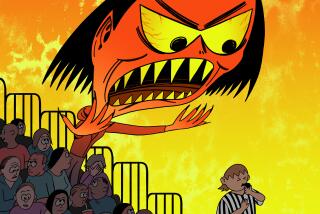Painful sports lessons
- Share via
Play through the pain. Get back in the game. Be a winner. These are the anthems of many professional athletes, but all too often they are being repeated by young athletes as well.
The values, often promoted by overzealous parents and coaches, take a toll on the estimated 30 million children who participate in organized sports in the United States each year. Overly aggressive play fueled by a win-at-all-costs mentality are increasingly being recognized as contributing factors in the injuries sustained by young players.
About one in three children, ages 5 to 14, who play organized sports will be injured at some point while participating in individual and team competition, according to a survey released this month by the National Safe Kids Campaign, a Washington, D.C.-based nonprofit group dedicated to preventing childhood injury.
“Professional athletes are in a business and are making money. They’re old enough to understand the consequences of what they’re doing,” said Charlie Maher, a psychology professor at Rutgers University who is also team psychologist for the Cleveland Indians baseball team and the Cleveland Cavaliers basketball team. “But a kid isn’t. ‘Play through the pain’ shouldn’t even be part of the vocabulary of youth sports. The primary focus should be health and safety.”
Although most injuries suffered by young athletes are rooted in physical causes, some have a mental component as well. As youngsters learn the intricacies of a sport, they must contend with growing bodies that can leave their coordination wobbly at times. And young athletes are often grouped by age, not by height and weight, resulting in opponents who are the same age, but vastly different in size. Particularly in contact sports such as football, the mismatches can lead to injury.
Permanent damage from a sports injury is rare among children, sports medicine experts say. The vast majority of injuries are cuts, bruises, sprains and broken bones, which almost always heal with little risk of long-term impairment. The real risk for children, whose bones are softer and break more easily than those of adults, lies in not letting bones heal properly. If a child re-injures the bone then the risk for premature arthritis becomes more likely.
Observers of youth sports in specialties from sports medicine to psychology point to rising pressure -- from parents and coaches alike -- that causes children to play at a level of intensity and competitiveness once reserved for collegiate and professional matches. The clamor for victory, so intense that it can trigger sideline screaming and brawls among adults, deeply affects children psychologically and encourages them to compete more recklessly, thus encouraging injury, youth athletic experts say.
Angry outbursts have spawned parent codes of conduct -- guidelines regulating adult behavior that, if not observed, can result in a ban from athletic events. One adopted in Massachusetts specifies parents will not “force” their children to play sports and will “promote the emotional and physical well-being of the athletes ahead of any personal desire [the parent] may have for [their] child to win.”
“Parents watch the professional ranks and they think their 6- or 7-year-old ought to be playing at the same level,” said Bill Prentice, a professor in the exercise and sports science department at the University of North Carolina at Chapel Hill. “Soccer moms and football dads are pushing harder than ever and it’s often just too much for the kids.”
The intense atmosphere can prompt a premature return to the athletic field after an injury, sports medicine experts say. Organized sports have a 20% re-injury rate, according to the National Youth Sports Safety Foundation, a nonprofit organization based in Boston that tracks youth injuries in sports. Kids often attempt to come back before rehabilitation because of external pressures focusing on personal character or team needs, youth athletic experts say.
“A lot of kids don’t want to be called a ‘baby,’ others are out to please the coach or their parents, and others are just kamikazes,” said Dan Gould, director of the Institute for the Study of Youth Sports at Michigan State University in East Lansing.
Studies of the relationship between psychological pressure and injury at any level of sport -- youth, pro or otherwise -- are scarce, experts acknowledge. But what research there is seems to support a link between mental state and injury.
For instance, Gould said one study found that teenage gymnasts with stress management counseling suffered significantly fewer injuries over the course of a season than a group without it. And many other studies have shown that “worrying about worrying” as opposed to concentrating on the task at hand dilutes attention, tenses muscles and sets the stage for injury, he added.
“Kids are vulnerable,” said Gould. “And parents and coaches have to remember, it’s only a game.”


